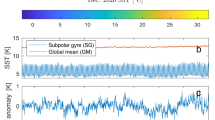Abstract
THE turbulent boundary layer at the ocean surface has some dynamical similarities to the atmospheric boundary layer1–4. The atmospheric turbulent boundary layer may exhibit not only random fluctuations but also spatially coherent, organized motion5,6. Thorpe1 conjectured that such organized motion should also be found in the upper ocean boundary layer in convectively unstable conditions. Here I report on observations made in the tropical Atlantic Ocean which confirm this view. Horizontal temperature profiles obtained at a depth of 2 m at night revealed ramp-like structures. Vertical velocity profiles in the upper few metres of the ocean was determined using a free-rising profiler, and exhibited abrupt changes corresponding to sudden changes in temperature. These features are known5,6 to be characteristic of spatially coherent, organized motions in turbulent boundary layers.
This is a preview of subscription content, access via your institution
Access options
Subscribe to this journal
Receive 51 print issues and online access
$199.00 per year
only $3.90 per issue
Buy this article
- Purchase on Springer Link
- Instant access to full article PDF
Prices may be subject to local taxes which are calculated during checkout
Similar content being viewed by others
References
Thorpe, S. A. Nature 318, 519–522 (1985).
Thorpe, S. A. Sci. progr., Oxf. 72, 189–206 (1988)
Csanady, G. T. J. phys. Oceanogr. 14, 402–411 (1984).
Soloviev, A. V., Vershinsky, N. V. & Bezverchnii, V. A. Deep Sea Res. 35, 1859–1874 (1988).
Antonia, R. A., Chambers, A. J., Frishe, C. A. & Van Atta, C. W. J. atmos. Sci. 36, 99–108 (1979).
Phong-Anant, D., Antonia, R. V., Chambers, A. J. & Rajagopalans, S. J. J. geophys. Res. 85, 424–432 (1980).
Brown, G. L. & Thomas, A. S. Physics Fluids 20, S243–S252 (1977).
Thorpe, S. A. & Hall, A. J. Nature 328, 48–51 (1987).
Volkov, Yu. A. et al. Izv. Akad. nauk SSSR, 25, 695–701 (1989).
Van Dyke, M. An Album of Fluid Motion (Parabolic, Stanford, 1982).
Soloviev, A. V. & Vershinsky, N. V. Deep Sea Res. 29, 1437–1449 (1982).
Shay, T. J. & Gregg, M. C. J. phys. Oceanogr. 16, 1777–1798 (1986).
Brubaker, J. M. Nature 330, 742–745 (1987).
Thorpe, S. A. & Hall, A. J. J. Fluid Mech. 101, 687–703 (1980).
Armorocho, J. & De Vries, J. J. J. geophys. Res. 85, 432–442 (1980).
Oceanography Tables (Hydrometeoizdat, Leningrad, 1975) (in Russian).
Soloviev, A. V. Izv. Akad. nauk SSSR 18, 751–759 (1982).
Author information
Authors and Affiliations
Rights and permissions
About this article
Cite this article
Soloviev, A. Coherent structures at the ocean surface in convectively unstable conditions. Nature 346, 157–160 (1990). https://doi.org/10.1038/346157a0
Received:
Accepted:
Issue Date:
DOI: https://doi.org/10.1038/346157a0
Comments
By submitting a comment you agree to abide by our Terms and Community Guidelines. If you find something abusive or that does not comply with our terms or guidelines please flag it as inappropriate.



